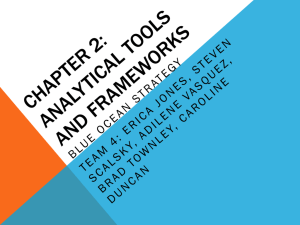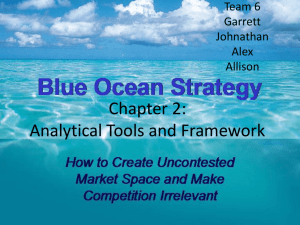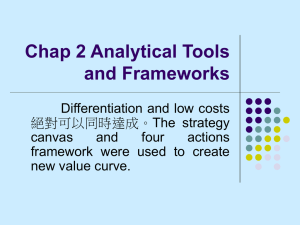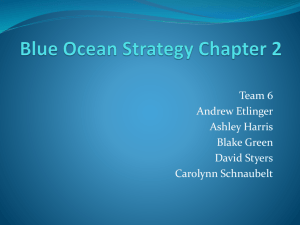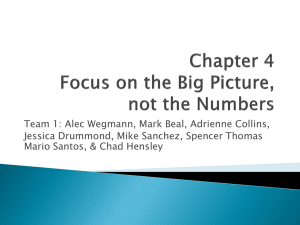Blue Ocean Chapter 2: Analytical Tools and Frameworks
advertisement
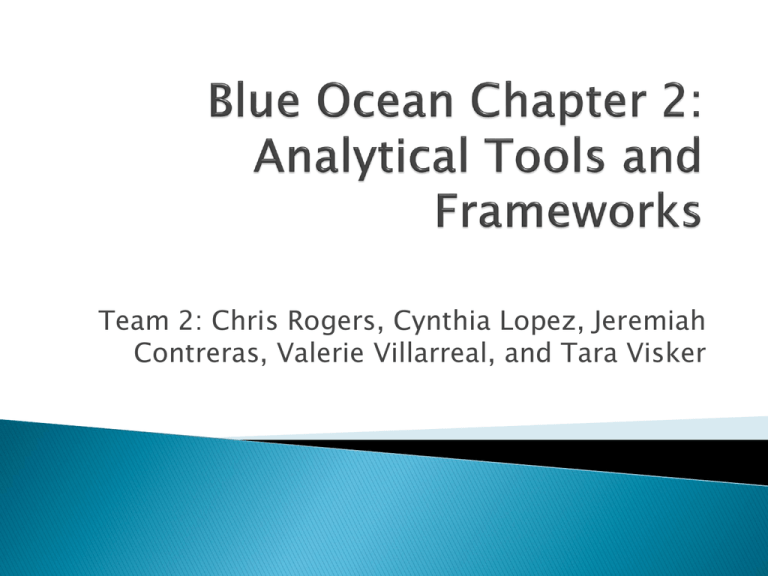
Team 2: Chris Rogers, Cynthia Lopez, Jeremiah Contreras, Valerie Villarreal, and Tara Visker The past decade has been spent trying to find analytical tools and frameworks for blue ocean strategists Where red ocean strategists have tools like porters five forces, blue ocean strategists have a lack of analytical tools for guidance This chapter examines strategies used by companies looking to make a move to blue oceans $20 Billion dollar industry that is intensely competitive There has been an increase in supply of wine makers, while the demand for wine in the U.S. has remained stagnant This has lead for the top eight companies to dominate controlling 75% of the market, while the other estimated 1600 wineries make up the other 25% The U.S. Wine industry faces intense competition, mounting price pressure, and flat demand For strategists, they are looking on how to break into blue ocean from this scenario The first tool that they will use to guide them is called Strategy Canvas Strategy Canvas is both a diagnostic and an action framework It has two purposes 1. capture the current state of play in the known market 2. propel users to action by reorienting focus. Ex: competitors to alternatives, and customers to noncustomers. The horizontal axis of a strategy canvas contains factors an industry competes on, while the vertical axis shows how much each company invested in that factor In the U.S. wine industry example research showed the over delivery on prestige and quality They determined many drinkers were turned off by wine, saying that they saw it as pretentious and intimidating The new solution for creating a blue ocean in this market should be; How to create a fun and nontraditional wine that is fun for everyone to drink? This could be extremely useful for the company we are doing our industry analysis on Nike They would be considered at the top of their current market, however they could grow and expand by looking at a strategy canvas This would allow them to point out key areas to reorient on, and create blue oceans for themselves. Eliminate ◦ Cookie Cutter Shoes ◦ One color scheme Reduce ◦ Barrier of athletes and “joe’s” ◦ Nike Commercial Raise ◦ “Coolness” of Shoes Create ◦ Icon ◦ Lifestyle Brand Focus Divergence Compelling Tagline [yellow tail], like Cirque du Soleil, created a unique and exceptional value curve to unlock a blue ocean. Focus: does not diffuse its efforts across all key factors of competition Tagline: “a fun and simple wine to be enjoyed every day” Diverges: value curve diverges from the other players;, a result of not benchmarking competitors but instead looking across alternative Every great strategy has focus, and a company’s strategic profile should clearly show it. When a company’s strategy is formed reactively as it tries to keep up with the competition, it loses its uniqueness The value curves of blue ocean strategists always stand apart. By applying the four actions of eliminating, reducing, raising, and creating, they differentiate their profiles from the industry’s average profile. A good strategy as a clear-cut and compelling tagline. A good tagline must not only deliver a clear message but also advertise an offering truthfully, or else customers will lose trust and interest. Focus- Nike has been focusing on athletic wear since 1950. Most used brand for athletic wear in many schools Divergence- New shoes that have the technology to track your movements and send them via bluetooth to an app. Basketball shoes that can measure your vertical jump Compelling Tagline- “Just do it” In the value curve of an industry is strategic knowledge on current status and future of a business Companies must understand how to read value curves in order to see future in the present “Does this business deserve to be a winner?” ◦ Focus ◦ Divergence ◦ A compelling tagline that speaks to market Value curve lacking focus: ◦ COST STRUCTURE tends to be high and BUSINESS MODEL tends to be complex in implementation and execution Value curve lacking divergence: ◦ Company’s strategy is a “me too” or no reason to stand apart in marketplace Value curve lacking compelling tagline: ◦ Likely to be internally driven or an example of innovation for innovation’s sake ◦ No great commercial potential ◦ No natural take off capability When value curve converges with its competitors Strategy tends to be trying to outdo competition on bases of cost or quality ◦ Signals slow growth ◦ Unless in a lucky industry that grows on its own accord When value curve shows it delivers high levels across all factors then the question is: ◦ “Does the company’s market share and profitability reflect these investments?” If no, company may be oversupplying customers To “value innovate” company must decide which factors to eliminate and reduce and those to raise/ create in order to construct a divergent value curve When a company’s value curve can be described as being “low-high-low-low-high-lowhigh” signals that a company doesn’t have a coherent strategy ◦ Strategy must be based on independent sub strategies Individually may make sense and keep business running but collectively they do little to distinguish company from the best competitor ◦ Often a reflection of an organization with divisional or functional silos Areas where a company is offering a high level on one competing fact while ignoring others that support that fact ◦ Example: Investing heavily in making company’s Web site easy to navigate, BUT failing to correct site’s slow speed of operation How does a company label the industry’s competing factors? ◦ Are they stated in terms buyers understand and value or are they in operational jargon Language used gives insight to a company’s strategic vision ◦ Built on an “outside-in” perspective Driven by the demand side ◦ Or “inside out” perspective Operationally driven Analyzing language helps a company understand how fat it is from creating industry demand Tools introduced in this chapter are essential analytics It is intersection between: ◦ Analytic techniques ◦ Six principles of formulating (in later chapters) ◦ Executing blue oceans That allow companies to break from competition and into uncontested market space

